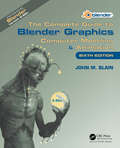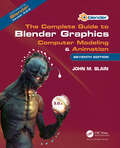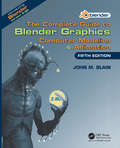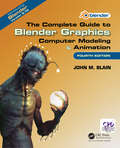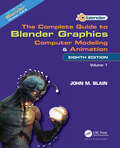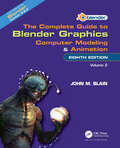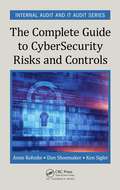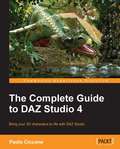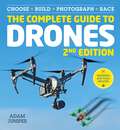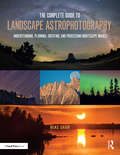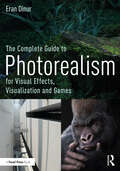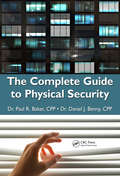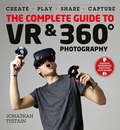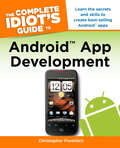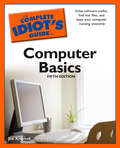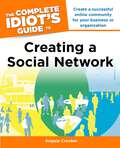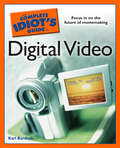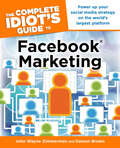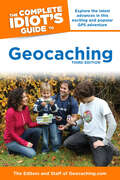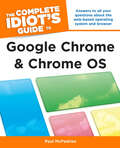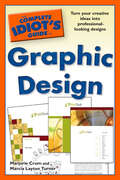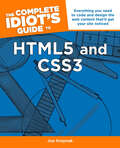- Table View
- List View
The Complete Guide to Blender Graphics: Computer Modeling & Animation
by John M. BlainBlenderTM is a free Open Source 3D Computer Modeling and Animation Suite incorporating Character Rigging, Particles, Real World Physics Simulation, Sculpting, Video Editing with Motion Tracking and 2D Animation within the 3D Environment. Blender is FREE to download and use by anyone for anything. The Complete Guide to Blender Graphics: Computer Modeling and Animation, Sixth Edition is a unified manual describing the operation of the program with reference to the Graphical User Interface for Blender Version 2.82a. A reader of the Sixth Edition should use Blender 2.82a when learning the program and treat it as a training exercise before using any later versions Key Features: The book provides instruction for New Users starting at the very beginning. Instruction is presented in a series of chapters incorporating visual reference to the program's interface. The initial chapters are designed to instruct the user in the operation of the program while introducing and demonstrating interesting features of the program. Chapters are developed in a building block fashion providing forward and reverse reference to relevant material.
The Complete Guide to Blender Graphics: Computer Modeling & Animation
by John M. BlainBlenderTM is a free Open Source 3D Computer Modeling and Animation Suite incorporating Character Rigging, Particles, Real World Physics Simulation, Sculpting, Video Editing with Motion Tracking and 2D Animation within the 3D Environment. Blender is FREE to download and use by anyone for anything. The Complete Guide to Blender Graphics: Computer Modeling and Animation, Seventh Edition is a unified manual describing the operation of the program with reference to the Graphical User Interface for Blender Version 3.0.0, including nearly 100 pages of completely new content. The book introduces the program’s Graphical User Interface and shows how to implement tools for modeling and animating characters and created scenes with the application of color, texture and special lighting effects. Key Features: The book provides instruction for New Users starting at the very beginning. Instruction is presented in a series of chapters incorporating visual reference to the program's interface. The initial chapters are designed to instruct the user in the operation of the program while introducing and demonstrating interesting features of the program. Chapters are developed in a building block fashion providing forward and reverse reference to relevant material. The book is also available in a discounted set along with Blender 2D Animation: The Complete Guide to the Grease Pencil.
The Complete Guide to Blender Graphics: Computer Modeling & Animation, Fifth Edition
by John M. BlainBlender™ is a free Open Source 3D Creation Suite supporting the entire modeling and animation pipeline – modeling, rigging, animation, simulation, rendering, compositing and motion tracking. The program also includes Video Editing and Grease Pencil 2D Animation. <P><P>The program is free to download and use by anyone for anything. <P><P>The Complete Guide to Blender Graphics: Modeling and Animation, 5th Edition is a unified manual describing the operation of Blender version 2.80 with its New Improved Interface, New Workspaces and New Eevee Render System. <P><P>This book introduces the program's Graphical User Interface and shows how to implement tools for modeling and animating characters and creating scenes with the application of color, texture and special lighting effects. <P><P>Key Features: <li>The book is designed to lead new users into the world of computer graphics using Blender 2.80 and to be a reference for established Blender artists. <li>The book presents instruction in a series of short chapters with visual references and practical examples. <li>Instructions are structured in a building-block fashion using contents in earlier chapters to explain more complex operations in later chapters.
The Complete Guide to Blender Graphics: Computer Modeling & Animation, Fourth Edition
by John M. BlainBlender is a free and open source graphics program for computer modeling and animation incorporating Photorealstic Rendering, Realistic Materials, Character Rigging, Sculpting, UV Unwrapping, Compositing, Simulation, Camera and Object Tracking, Game Creation and Video Editing. The program is comprehensive. The interface is extensive. The creative experience is fantastic. The Complete Guide to Blender Graphics: Computer Modeling and Animation is a unified learning manual for beginners and a reference for advanced users. The manual introduces the basic components of the Blender program with reference to the interface using written instruction in conjunction with illustrations and examples. In this fourth edition of The Complete Guide to Blender Graphics the author has included changes to the program which eventuate as Blender is developed and improved. New subject matter has been added with examples. <P><P> Key Features: <li>Contents are structured in a building-block fashion, using content covered in early chapters to explain more complex content in later chapters. <li>Describes the basic operations of the interface and the majority of its functions with visual references and practical examples <li>Significantly expands discussion of advanced features providing the reader with a guide to the full potential of the program.
The Complete Guide to Blender Graphics: Computer Modeling and Animation: Volume One
by John M. BlainBlenderTM is a free Open-Source 3D Computer Modeling and Animation Suite incorporating Character Rigging, Particles, Real World Physics Simulation, Sculpting, Video Editing with Motion Tracking and 2D Animation within the 3D Environment. Blender is FREE to download and use by anyone for anything. The Complete Guide to Blender Graphics: Computer Modeling and Animation, Eighth Edition is a unified manual describing the operation of the program, updated with reference to the Graphical User Interface for Blender Version 3.2.2, including additional material covering Blender Assets, Geometry Nodes, and Non-Linear Animation. Divided into a two-volume set, the book introduces the program’s Graphical User Interface and shows how to implement tools for modeling and animating characters and created scenes with the application of color, texture, and special lighting effects. Key Features: The book provides instruction for New Users starting at the very beginning. Instruction is presented in a series of chapters incorporating visual reference to the program's interface. The initial chapters are designed to instruct the user in the operation of the program while introducing and demonstrating interesting features of the program. Chapters are developed in a building block fashion providing forward and reverse reference to relevant material. Both volumes are available in a discounted set, which can also be purchased together with Blender 2D Animation: The Complete Guide to the Grease Pencil.
The Complete Guide to Blender Graphics: Computer Modeling and Animation: Volume Two
by John M. BlainBlenderTM is a free Open-Source 3D Computer Modeling and Animation Suite incorporating Character Rigging, Particles, Real World Physics Simulation, Sculpting, Video Editing with Motion Tracking and 2D Animation within the 3D Environment. Blender is FREE to download and use by anyone for anything. The Complete Guide to Blender Graphics: Computer Modeling and Animation, Eighth Edition is a unified manual describing the operation of the program, updated with reference to the Graphical User Interface for Blender Version 3.2.2, including additional material covering Blender Assets, Geometry Nodes, and Non-Linear Animation. Divided into a two-volume set, the book introduces the program’s Graphical User Interface and shows how to implement tools for modeling and animating characters and created scenes with the application of color, texture, and special lighting effects. Key Features: The book provides instruction for New Users starting at the very beginning. Instruction is presented in a series of chapters incorporating visual reference to the program's interface. The initial chapters are designed to instruct the user in the operation of the program while introducing and demonstrating interesting features of the program. Chapters are developed in a building block fashion providing forward and reverse reference to relevant material. Both volumes are available in a discounted set, which can also be purchased together with Blender 2D Animation: The Complete Guide to the Grease Pencil.
The Complete Guide to Cybersecurity Risks and Controls (ISSN)
by Dan Shoemaker Anne Kohnke Ken E. SiglerThe Complete Guide to Cybersecurity Risks and Controls presents the fundamental concepts of information and communication technology (ICT) governance and control. In this book, you will learn how to create a working, practical control structure that will ensure the ongoing, day-to-day trustworthiness of ICT systems and data. The book explains how to establish systematic control functions and timely reporting procedures within a standard organizational framework and how to build auditable trust into the routine assurance of ICT operations. The book is based on the belief that ICT operation is a strategic governance issue rather than a technical concern. With the exponential growth of security breaches and the increasing dependency on external business partners to achieve organizational success, the effective use of ICT governance and enterprise-wide frameworks to guide the implementation of integrated security controls are critical in order to mitigate data theft. Surprisingly, many organizations do not have formal processes or policies to protect their assets from internal or external threats. The ICT governance and control process establishes a complete and correct set of managerial and technical control behaviors that ensures reliable monitoring and control of ICT operations. The body of knowledge for doing that is explained in this text. This body of knowledge process applies to all operational aspects of ICT responsibilities ranging from upper management policy making and planning, all the way down to basic technology operation.
The Complete Guide to DAZ Studio 4
by Paolo CicconeThe book builds up a complete project from scratch and demonstrates the power of DAZ to create life-like characters. The book is replete with detailed examples and instructions on creating a tailor-made marvel out of scratch.This book can be used by anybody who has DAZ Studio 4, regardless of their level of familiarity with the program or the concepts of 3D art.
The Complete Guide to Drones Extended 2nd Edition
by Adam JuniperIf you think you need a boarding pass to fly, you're really missing out... Today, drones are everywhere. From film studios to farms, they're in the hands of photographers, commercial surveyors and racers alike. This fully illustrated book explains how drones developed, where they're going and which one you should choose. It even includes complete instructions to build both a simple drone and a super-fast FPV racer yourself.Whether you're flying indoors or out, buying or building, this book covers everything:¦ Understand the Jargon Flying has a lot of unfamiliar terminology, but this book will make it easy to master.¦ Business or Pleasure Every type of multicopter you might want is introduced, including explanations of which is best suited for what role.¦ Get the Best Pictures This edition includes an extended guide to the tech and composition tricks you can use to make your pictures stand out of the pack.¦ Get the Best Video A new shot-guide shows you how to get the most engaging aerial video, whatever your drone.¦ Be a Winning FPV Racer There are two complete step-by-step instructions for building your own drones inside: an FPV racer, or a surprisingly cheap wooden drone - both great projects.Following the worldwide success of the first edition, which has been translated into numerous languages, this second edition is not only fully updated to keep pace with the laws and technology, but also extended to thoroughly cover the fast-growing new sport of FPV drone racing, while still including a comprehensive guide to learning to fly any drone.
The Complete Guide to Drones Extended 2nd Edition
by Adam JuniperIf you think you need a boarding pass to fly, you're really missing out... Today, drones are everywhere. From film studios to farms, they're in the hands of photographers, commercial surveyors and racers alike. This fully illustrated book explains how drones developed, where they're going and which one you should choose. It even includes complete instructions to build both a simple drone and a super-fast FPV racer yourself.Whether you're flying indoors or out, buying or building, this book covers everything:¦ Understand the Jargon Flying has a lot of unfamiliar terminology, but this book will make it easy to master.¦ Business or Pleasure Every type of multicopter you might want is introduced, including explanations of which is best suited for what role.¦ Get the Best Pictures This edition includes an extended guide to the tech and composition tricks you can use to make your pictures stand out of the pack.¦ Get the Best Video A new shot-guide shows you how to get the most engaging aerial video, whatever your drone.¦ Be a Winning FPV Racer There are two complete step-by-step instructions for building your own drones inside: an FPV racer, or a surprisingly cheap wooden drone - both great projects.Following the worldwide success of the first edition, which has been translated into numerous languages, this second edition is not only fully updated to keep pace with the laws and technology, but also extended to thoroughly cover the fast-growing new sport of FPV drone racing, while still including a comprehensive guide to learning to fly any drone.
The Complete Guide to Landscape Astrophotography: Understanding, Planning, Creating, and Processing Nightscape Images
by Michael C ShawThe Complete Guide to Landscape Astrophotography is the ultimate manual for anyone looking to create spectacular landscape astrophotography images. By explaining the science of landscape astrophotography in clear and straightforward language, it provides insights into phenomena such as the appearance or absence of the Milky Way, the moon, and constellations. This unique approach, which combines the underlying scientific principles of astronomy with those of photography, will help deepen your understanding and give you the tools you need to fulfil your artistic vision. Key features include: • Distinguished Guest Gallery of images from renowned nightscape photographers such as Babak Tafreshi, Bryan Peterson, Alan Dyer, Brenda Tharp, Royce Bair, Wally Pacholka, and David Kingham • The twenty-five best landscape astrophotography subjects and how to photograph them • Astronomy 101 - build your knowledge of night sky objects and their motion: the Milky Way, moon, Aurora Borealis/Australis, constellations, meteors and comets • Information on state-of-the-art planning software and apps designed to enable you to capture and enhance your landscape astrophotography • Field guide for creating a detailed plan for your night shoot • Description of the best moon phases for specific types of nightscape images, and the best months and times of night to see the Milky Way • How-to guide for creating stunning time-lapse videos of the night sky, including Holy Grail transitions from pre-sunset to complete darkness • Four detailed case studies on creating landscape astrophotography images of the Milky Way, full moon, star trails, and constellations
The Complete Guide to Photorealism for Visual Effects, Visualization and Games
by Eran DinurThis book offers a comprehensive and detailed guide to accomplishing and perfecting a photorealistic look in digital content across visual effects, architectural and product visualization, and games. Emmy award-winning VFX supervisor Eran Dinur offers readers a deeper understanding of the complex interplay of light, surfaces, atmospherics, and optical effects, and then discusses techniques to achieve this complexity in the digital realm, covering both 3D and 2D methodologies. In addition, the book features artwork, case studies, and interviews with leading artists in the fields of VFX, visualization, and games. Exploring color, integration, light and surface behaviour, atmospherics, shading, texturing, physically-based rendering, procedural modelling, compositing, matte painting, lens/camera effects, and much more, Dinur offers a compelling, elegant guide to achieving photorealism in digital media and creating imagery that is seamless from real footage. Its broad perspective makes this detailed guide suitable for VFX, visualization and game artists and students, as well as directors, architects, designers, and anyone who strives to achieve convincing, believable visuals in digital media.
The Complete Guide to Physical Security
by Daniel J. Benny Paul R. BakerTo adequately protect an organization, physical security must go beyond the "gates, guns, and guards" mentality that characterizes most security programs. Creating a sound security plan involves understanding not only security requirements but also the dynamics of the marketplace, employee issues, and management goals. The Complete Guide to Physica
The Complete Guide to VR & 360 Photography: Make, Enjoy, and Share & Play Virtual Reality
by Jonathan TustainThe Complete Guide to VR will help you get to grips with this exciting new technology from first principles, so you know what's out there, and what you want.Discover all there is to know about home VR systems, whether they're computer-based, or work using your mobile phone. This book will introduce you to a whole spectrum of VR possibilities including VR games, creating your own VR films and exploring the world using it.
The Complete Guide to Videogame Performance Directing: Place, Time, Action
by Tom KeeganThis book teaches the complex, sometimes confounding, and often beautiful art of directing live performance for videogames. Starting from a clear and comprehensive introduction to the nuts and bolts of directing on the motion capture floor and in the voiceover booth, this book dives deeper with concrete examples from the author’s 25‑year career directing seminal games from the early years to today’s blockbusters.Identifying the Place (What is the physical environment?), Time (What just happened?), and Action (What do the characters want?) of every scene empowers directors with essential tools to dive straight into the subtext, the life below the words. Through step‑by‑step instructions, this book shows how to make scenes and lines come alive. It offers real‑world advice on everything from casting to table reads, rehearsal, and production days. In addition, readers can find valuable advice about self‑care and sustaining a long‑term career as a performance director.This book is sure to be an essential resource for directors, actors, voiceover artists, and game developers who want to master videogame performance.
The Complete Idiot's Guide to Android App Development: Learn the Secrets and Skills to Create Best-Selling Android Apps
by Christopher FroehlichAn operating manual for the hottest mobile operating system. The Complete Idiot's Guide® to Android App Development gets novice developers up and running quickly on creating their very own mobile applications, with step-by-step instruction on everything they need to design, develop, test, and publish their fully-featured apps. The Android operating system is now the largest mobile platform in the U.S., and there are now more than 90,000 apps available. Android is completely open and free to all developers. Topics covered include: • Designing effective and easy-to-navigate user interfaces for apps • Adding audio and video support to apps • Making the most of Android's hardware, including GPS, social media, built-in camera, and voice integration • Publishing application to the Android market
The Complete Idiot's Guide to Computer Basics, 5th Edition
by Joe KraynakTime for an upgrade! The fifth edition of The Complete Idiot's Guide® to Computer Basics places the reader in charge of the computer, rather than the other way around, and places the focus on software troubleshooting rather than hardware techno-babble. The reader wants to do something practical with his or her computer—this book shows them how.• Covers basic office programs and how to manage photo, video, and music files• Advice on safe web-surfing, including coverage of newsgroups, message boards, and mailing lists• New green computing initiatives that help protect the environment• Maintenance and upgrading information
The Complete Idiot's Guide to Creating a Social Network
by Angela CrockerGet connected The Complete Idiot's Guide® to Creating a Social Network takes reader through the technical aspects of creating a successful site-and addresses the responsibilities involved in running one. • Covers how to build and maintain a website through a white label service such as GroupSite or Ning, and by using customized software for creating one's own network • Addresses such issues as privacy, authenticity, fostering participation, quality versus quantity, moral and ethical guidelines, and much more • Americans now average more than six hours per month on social networks, with an active unique social network audience estimated to be from 149 million—up 29 percent from 2009 • Ad revenue taken in by social networking sites is growing rapidly, and many people and companies are looking for ways to get in on this growth
The Complete Idiot's Guide to Digital Video
by Karl BardoshJoin the digital revolutionWith the availability and affordability of digital movie-making equipment, it&’s now easier than ever for aspiring filmmakers to create the great movie they&’ve always wanted to make. From information on creating mini-films on a PDA to making low-budget, full-length digital movies, The Complete Idiot&’s Guide® to Digital Video provides all the information you need to turn your idea into reality.• A must-read for every film student or novice• Covers all aspects of production, from casting and directing to light and sound to digital editing• Includes 8–page, 4–color insert• Up–to–date recommendations on equipment and software• Clear, easy-to-follow instructions and guidance, as well as all the practical, artistic, and technical &“step–by–step&” advice that only an experienced writer/director can offer
The Complete Idiot's Guide to Facebook Marketing: Power Up Your Social Media Strategy on the World’s Largest Platform
by Damon Brown John Wayne ZimmermanCovers all aspects including Facebook Marketplace, Facebook Places, and Facebook Deals
The Complete Idiot's Guide to Facebook, 3rd Edition: Stay on Top of the Latest Changes with This Up-to-Date Edition
by Joe Kraynak Mikal E. BelicoveFacebook is by far the most popular social networking site, but it is not as user-friendly as the service would like people to think. It leaves many users scratching their heads over even the most fundamental features, such as the difference between their Wall and their News Feed. And Facebook's help system is woefully inadequate. The Complete Idiot's Guide® to Facebook, Third Edition, gets readers registered and touring Facebook in the very first chapter and never lets up as it reveals the features that have made Facebook so amazingly popular. Users discover how to:- Flesh out and protect the all new personal profile- Track down long lost friends, family members, and classmates- Communicate via status updates, email, and chat- Share photos and video- Make the best use of the new Timeline feature- Take advantage of Facebook's new location-based functionality- Schedule real world get-togethers and send out invitations- Share common interests in groups- Play games- Understand Facebook's dizzying array of privacy options that dictate who sees one's content- Buy and sell stuff in the Facebook Marketplace, and more.Readers also learn how to tap the power of Facebook for more than simply personal use-such as personal branding; marketing a business, product, service, or non profit; or promoting a worthy cause.
The Complete Idiot's Guide to Geocaching, 3rd Edition: Explore the Latest Advances in This Exciting and Popular GPS Adventure
by Editors & Staff Geocaching.comGeocaching has steadily grown into a fun and enduring outdoor adventure and with the popularity of GPS units and the development of applications for nearly all of the most popular smartphone platforms, it has become an adventure that's available to pretty much anyone. In The Complete Idiot's Guide® to Geocaching, Third Edition, the editors and staff of Geocaching.com open the world of geocaching up to a much broader audience and take the reader through all of the core essentials for caching including how to play, tips and tricks for finding and placing caches, variations on traditional caching, and much more. In addition, the reader can learn about exciting new changes to the game and the new GPS-enabled games that will take cachers to an entirely new level of fun and adventure.
The Complete Idiot's Guide to Google Chrome and Chrome OS
by Paul McFedriesA nontechnical manual for groundbreaking technology The Complete Idiot's Guide® to Google Chrome OS presents readers with a clear overview of Google's free operating system—targeting users of netbook computers and allowing them to work primarily on the web—including how to send email, work with pictures, save and manage files, use common office applications as well as more specialized programs, and deal with problems. • Available day-and-date with the software • Chrome OS will be free, making it very competitive with Windows 7 • Google boasts that Chrome OS will start up and get the user onto the web in a few seconds, without having to contend with viruses, malware, and security updates
The Complete Idiot's Guide to Graphic Design: Turn Your Creative Ideas into Professional-Looking Design
by Marcia Layton Turner Marjorie CrumIf you can dream it, you can design it Whether your goal is to design your own marketing materials, launch a visually compelling blog, or just have some fun creating your own CD covers, The Complete Idiot&’s Guide® to Graphic Design is your one-stop reference. Presented in an intuitive, accessible format, here are the fundamental elements of design and design principles, as well as instruction on how to apply those elements and principles to a variety of projects. • Covers art supplies, software, concept development, reproduction needs, and much more • Sample projects include business cards, print and web ads, and graphic T-shirts • Follows the success of other titles aimed at the aspiring artist, including the Complete Idiot&’s Guide® titles on digital photography, drawing, and manga
The Complete Idiot's Guide to HTML5 and CSS3: Everything You Need to Code and Design the Web Content and That’ll Get Your Site
by Joe KraynakCreate dynamic, interactive websites with HTML5 and CSS3. HTML5 and CSS3 are the newest revisions of the primary standards for structuring and styling web content—major updates that enable designers and developers to streamline source code and publish more dynamic, interactive content without having to learn complex scripting languages. The Complete Idiot's Guide® to HTML5 and CSS3 provides both new and existing web developers the tools they need to code and design the web content that people increasingly expect to experience when they surf the web. Even better, you learn HTML5 and CSS3 in the context of building a website with a content management system (CMS), such as WordPress. You can then apply your knowledge of HTML5 and CSS3 to customize your site, instead of starting from scratch. You discover how to: • Design and maintain a website using web-based tools instead of a complicated HTML editor. • Code pages properly using the new HTML5 structure tags. • Embed audio and video using the new HTML5 tags. • Apply a CSS theme to format pages, and customize the theme using CSS3 styles. • Use CSS3 to round box corners and make images and backgrounds more or less transparent. • Take full advantage of new CSS3 transformation and animation features to animate objects on a page, create image rollovers, and build your own drop-down menus. • Test and fine-tune your site to make it load faster and look just right. • Perform an SEO audit of your site and keyword-optimize your site's content. The Complete Idiot's Guide® to HTML5 and CSS3 features: • 16-page color insert • HTML5 Quick Reference • CSS3 Properties and Values Quick Reference • HTML Special Characters and Symbols Quick Reference • Speak Like a Geek Glossary From the Author Although this book focuses primarily on HTML5 & CSS3, it presents these topics in the context of building a web site. When you're first getting started, building a site from scratch using only HTML and CSS can be overwhelming. You're usually better off starting with a content management system (CMS), such as WordPress, and a pre-designed theme. You can then use your knowledge of HTML5 and CSS3 to customize your site, instead of starting from scratch. This approach gets your site up and running as quickly as possible and allows you to learn more at a more comfortable pace.
